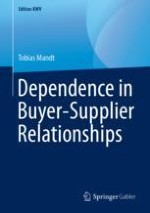2018 | Buch
Über dieses Buch
Organizations frequently rely on the support of external parties to access necessary resources. In many cases, the resulting buyer-supplier relationships last for decades; some might even become indispensable for one or both parties in achieving its desired business goals. These dependencies between organizations are ubiquitous. This book focuses on such instances, discussing them in a cumulative manner: It begins with an introduction of previous research on the issue, before empirically explaining the emergence of dependencies, their different forms of existence and management approaches as well as its development over time.
This book is of special interest for scholars focusing on dyadic partnerships within the domains of industrial marketing, supply chain management or strategic purchasing. Practitioners involved in managing long term buyer-supplier relationships in goods- as well as service-oriented industries might find it insightful as well.
Anzeige
